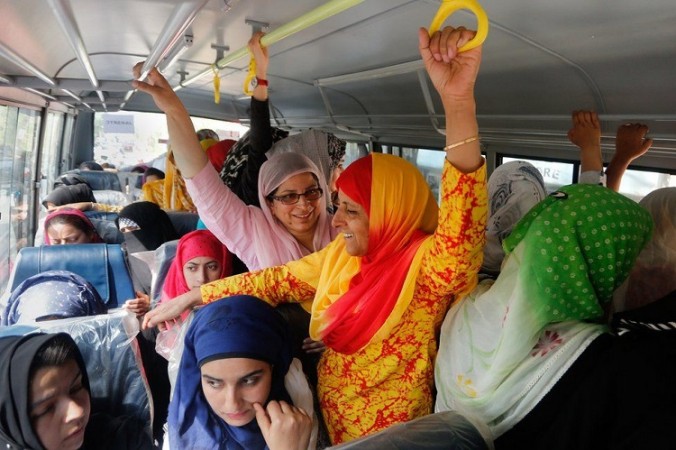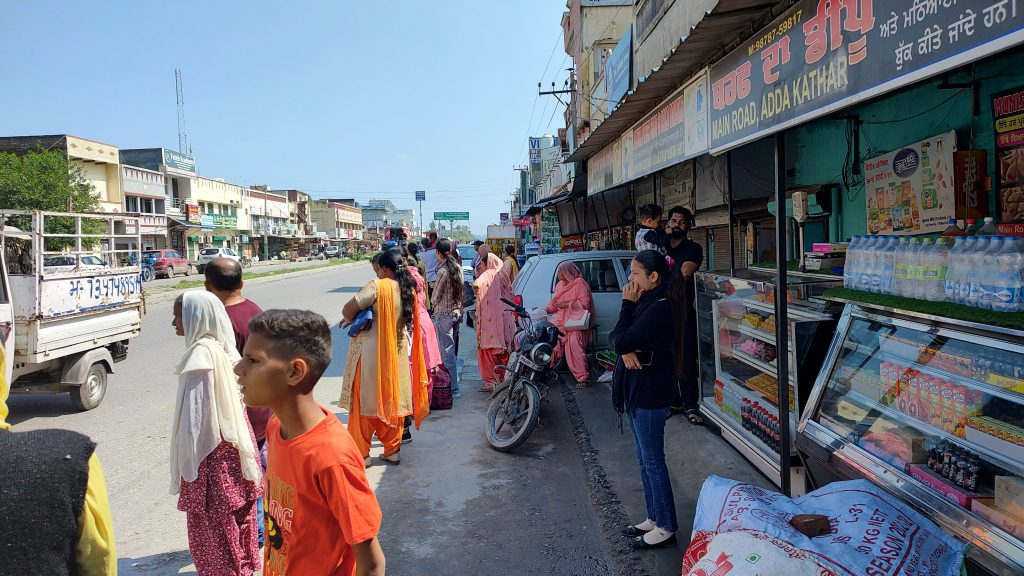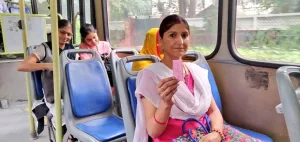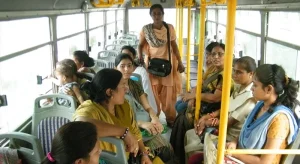Punjab’s Free Bus Scheme Has Changed Women’s Lives But Its Future Is Shaky
The number of women commuters has doubled but with no funds, public bus networks are stretched, leading to overcrowding and disrupted schedules

The Punjab government scheme to allow women and girls free rides on state-run buses has dramatically increased the number of female commuters, show official data. But despite the difference it makes to the lives of women, the lack of a dedicated budget and an overworked fleet could jeopardise the scheme, we find.
Extensive interviews with working women, homemakers and students from across Jalandhar, Hoshiarpur and Ludhiana show that the free bus ride scheme for women – also in effect in Karnataka, Tamil Nadu, and Delhi – has brought Punjab’s women more savings and employment gains. This, along with increased leisure opportunities, has given them greater visibility in public spaces otherwise dominated by men.
Ravjot Kaur, 32, a nurse who works in Jalandhar city, has been waiting patiently for a bus at the Adampur town bus stand. There are plenty of private buses heading for the city but she is particular about only taking a public bus.
“I would rather take the [state] roadways bus or any other sarkari bus. It’s free and helps me save money on travel,” says Ravjot Kaur. The fare on private buses for this stretch is Rs 50-60 and saving this fare through the free bus scheme becomes crucial for her, especially since she needs a last-mile auto-rickshaw ride to reach her clinic. A significant portion of her monthly income of Rs 20,000 is already dedicated to her children’s education.
It was in March 2021 that the Punjab government made bus travel free for women and girls. An initiative of two departments – social security and women and child development – its goal was to promote social inclusion by enhancing women’s mobility. But the scheme is only applicable to women who can furnish proof of residence in the state and only for state transport systems such as the PEPSU Road Transport Corporation (PRTC), PUNBUS, Punjab Roadways and City Services operated by Local Bodies.
A central flaw with the scheme is that there is no budget allocated to it, as we said earlier. To keep the scheme running, last year the Punjab Government owed Rs 187 crore to the PRTC, leaving it short of funds to pay salaries and invest in new buses. The free ride scheme itself is not listed under the gender budget for the year 2023-24 and according to The Tribune, the scheme might be discontinued or restricted to weekends given its financial non-viability.
Women Commuters Double
On the face of it, the Punjab experiment has been successful: data show a doubling in the usage of public buses by women and girls since April 2021 when the scheme was introduced – going up from 6.1 million to 11.2 million in just eight months to November 2022. (The Punjab government had not previously maintained records of women bus users.) The surge in numbers surpasses female ridership in Delhi – approximately 10% between October 29, 2019 and November 19, 2019 when it introduced a free bus scheme for women commuters.
The 2016, National Sample Survey Organisation (NSSO) data also shows that more than 60% of both rural and urban households use the bus as their primary mode of transport, followed by auto-rickshaws.
Public transport has an even more critical role in the lives of women: Census 2011 data show that 84% of women’s journeys are made using public, intermediate public, and non-motorised modes of transport. This means a bad public transit system can have a debilitating impact on women’s lives, professional and otherwise.
A World Bank report reiterates this fact – women display greater reliance on public transportation than men, and their travel patterns and timings are often staggered. It is common for them to combine multiple destinations into a single trip, making the most efficient use of their time and resources.
One reason to push such schemes is to increase women’s participation in the labour market through increased mobility. As per the Periodic Labour force survey, 2020-21, the labour force participation rate of women in India stands at 25.5%. In Punjab, the number is even lower at 13.9%, amongst the lowest across Indian states.
A study by the Asian Development Bank concludes that women turn down better-paying jobs if it means an unsafe commute, requires travel at odd times of the day, or does not satisfy other lifestyle conditions. This traps them in cheaper but slower modes of transport, further adding to their time poverty. This also means additional burden on their domestic and care work responsibilities.
More Time For Leisure
Mobility gains have other advantages too. “To women, improved mobility means freedom—an avenue to access knowledge, information, education, and most importantly, the freedom to make decisions for themselves,” says Geetha Nambisan, a Gender and Inclusivity consultant at Housing and Land rights Network and former director of Jagori.
We met Kusum Rani, a domestic worker and resident of Piplanwala village in Hoshiarpur district, and she says the scheme has opened up more opportunities for leisure and socialising, improving the quality of her life. “Now whenever I have free time I make sure to visit my mother or sister living at Hoshiarpur, without having to worry about travel costs,” she says.
Navdeep Asija, traffic advisor to the government of Punjab, believes that the scheme alleviates the financial burden on women with limited means: “It enables them to save money that would have otherwise been spent on transportation, allowing them to allocate those resources to other important needs for themselves and their families.”
Overcrowding, Long Wait
However, as we discuss later, the scheme’s success has also brought in its wake some challenges caused by its poor budgeting, planning and management – overcrowding of buses, long waiting times and a tendency among bus operators to avoid stops where women commuters are present in large numbers.
“I have to wait longer for the government buses because I get to travel free. But most drivers don’t even halt the buses. On days when I get late, I choose to take whatever bus comes first, public or private,” says Suman, a college student studying in Phagwara who wished to be identified only by her first name. At Mandiala village where she lives, she spends 30 minutes to an hour waiting for a public bus to take her to her college and when it does come by there are no unoccupied seats. There are days when she does the entire commute standing.

Reema Sharma, a 48-year-old home-maker from Dheypur village in Jalandhar, says she never seems to find a seat in a state bus ever since the scheme was introduced and she would rather spend money on a private bus and travel in comfort. “Sundays are particularly challenging for me as I need to attend church in Jalandhar city. Every bus, even private ones, is overcrowded as if they are operating beyond their capacity. This was not the case earlier. Buses used to make more frequent stops but these days even waiting for an hour isn’t enough,” she says.
Women at the Kathar bus stop, situated along the National Highway in Adampur tehsil, also complained about buses not stopping for passengers especially if they see female passengers waiting in large numbers. [Anganwadi workers waiting to reach a protest site in Delhi last year told a Behanbox reporter that buses speed past when they see a big group of women at a stop.]
Historically and even now, women often face mobility hurdles due to safety concerns, sociocultural norms and differential access to private vehicles at home.
“The more buses I miss in the evening, the later I get home. I would gladly save Rs 100 and take a state bus but you have to be lucky to get one,” says Harpreet Kaur Grewal, a teacher who was waiting at Jalandhar’s Rama Mandi bus stop for a bus to Ludhiana where she works. The ride takes around an hour.
Mobility also forms an important aspect of ‘Woman’s Quest for Freedom’, as described by Frances Willard in her 1895 book, A Wheel Within a Wheel. Women’s right to the city can be claimed when they are able to move freely in the city, either to go from one place to another or simply loiter without cultural and economic encumbrances.
Overworked Fleet
“My parents wait patiently for me in the evenings. But there are days when they are frustrated enough [with the commute challenges] to tell me they won’t be sending me to college and they would prefer that I stay at home. Reaching home early is a luxury now. Either I save money or reach home early or take a private bus,” says Harpreet Grewal. PUNBUS and PRTC buses also ignore small stops, she complains, unlike private operators.
We speak to Mehtab Singh, a bus conductor with Punjab Roadways about why buses run overcrowded and why they do not stop at designated halts. “The [state] buses are constantly packed with passengers. If they are already overcrowded from the first stop, where will we accommodate other passengers? Private buses are profit-oriented. They don’t even hesitate to exceed their capacity by threefold. Their primary concern is maximising profits, not passenger comfort or safety,” he says.
The state’s Director, State Transport puts the total number of government-run buses in the state at 1807. This translates to approximately 6.5 buses per 100,000 population, which is significantly lower compared to the global standard of 50-120 buses per 100,000 people. Even more concerning is the scarcity of buses in rural areas – only 73 all told. Considering that 62.5% of the state’s population lives in villages, this figure is critically inadequate.
Simrandeep Virk who lives in Bara Pind village in Ludhiana district struggles everyday to get to an IELTS institute in Phagwara, 18 km away. There are no public buses in the area and she depends on her father or brother to drop her to the bus stand in neighbouring Goraya and pick her up on return in the evening. “At times, because of my coaching [timetable] I have to travel home late. Even though government buses are free, I feel unsafe in overcrowded buses especially in the evenings,” she says.
Earlier she banked on the discounted monthly bus pass offered by the government to students. The pass cost her Rs 600-800. She is relieved she no longer has to turn to her parents for money when they are already funding her studies.
The scheme is limited to women who are “residents” of the state, as we noted earlier. However, 70% of the state’s urban workforce (there is no gender disaggregated data on this) is from outside the state and this exclusivity condition leaves out the entire population of female migrant workers, as is the case with Karnataka. A similar scheme in Tamil Nadu, and Delhi allows free bus access to all women, irrespective of their resident status. Also the scheme does not extend to gender minorities which is being considered in Karnataka and Tamil Nadu.
Way Forward
“Gender is one of the key socio-demographic variables that can influence travel behaviour, but it is often the least understood,” says a report of the OECD.
A study conducted by the Ola Mobility Institute in 20 Indian cities found that women’s preference for public transport declines sharply with an increase in individual monthly incomes. Free bus ride schemes can help shift their preference to public transport. But poor management of crowding and schedules might push them back to private options.
It is also important to ensure the financial viability and efficiency of the scheme. Says Asija: “The state has additional responsibilities to ensure an effective and sustainable public transportation system. A comprehensive assessment of the existing transportation infrastructure and demand patterns can help determine the required number of buses. The government should adopt an integrated approach to transport planning, considering multiple modes of transportation such as buses, cycling, and walking [eased by the availability of dedicated walking/cycling tracks].”
Many state transport systems are facing a resource crunch. The Bengaluru bus system is one such, having incurred a loss of Rs 400 crore in 2021. This forces transport operators to restrict their services and increase fares. How can they then cope with the financial load of a free ride scheme?
States must cross-subsidise such schemes, says Paulose N Kuriakose, a transport expert and professor at school of planning and architecture, Bhopal. This can be done by levying an impact fee on the purchase of private vehicles.
“If we calculate this impact fee over the purchase of a new vehicle over time, even at a rate of 1% or 2% of the cost of the vehicles, a large revenue can be generated by the state,” he says. “Similarly, there could be a charge for using public parking spaces.”
Many countries, such as France or the US, use similar strategies to fund and subsidise the use of public transport methods. In France, a fraction of the wage bill is collected as transportation taxes from employers. Most of the money generated is used to fund the operational cost of public transport and the rest is used as an investment in the transportation. In 2010, for example, this tax financed nearly 40% of the operational cost for the public transport network in Ile-de-France, which includes Paris. In the US, the federal government imposes a gasoline tax of 18 cents per gallon. A portion of the revenue generated from this tax is allocated to support public transportation operations.
We believe everyone deserves equal access to accurate news. Support from our readers enables us to keep our journalism open and free for everyone, all over the world.



